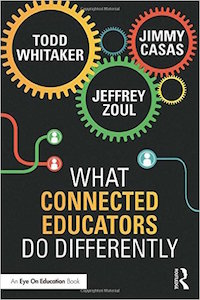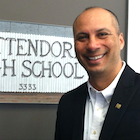Connected Educators Strive To Be ‘Genius Makers’
 Adapted with permission from What Connected Educators Do Differently (Routledge, 2015). Click on the eResources tab at the publisher’s page to download a free list of Twitter #edchats by states and by topics.
Adapted with permission from What Connected Educators Do Differently (Routledge, 2015). Click on the eResources tab at the publisher’s page to download a free list of Twitter #edchats by states and by topics.
By Todd Whitaker, Jeffrey Zoul and Jimmy Casas
Getting connected to other educators around the world is actually quite fun once you learn how to go about creating an online learning network and begin interacting with peers who share your professional interests. But if it were only about meeting new colleagues and having fun, we doubt that anyone would continue along this path for long.
What keeps connected educators energized is not only the people with whom they connect, but also the ideas they get connected to, ideas that help them get better at what they do so that their students will have, as connected education leader Tom Murray said to us, “a better tomorrow than they had today.”

Todd Whitaker
With knowledge so readily accessible in today’s technological society, it is no longer the case that any one person has (or needs) the answers to all of life’s questions or that any single individual is the smartest person in the room. Instead, we have reached a point whereby the smartest person in the room is not a person at all, but the room itself, meaning the collective wisdom of all who are gathered together, whether face to face in an actual room or connected together in a virtual room of some sort.
The ideas we can brainstorm together are larger in number and higher in quality than the ideas we can generate alone. To gain access to the best ideas in education today – and to share your own voice, offering ideas that you have seen work – you must be connected beyond your immediate network of colleagues.
We will not be able to do all that we can for the students we ultimately serve if we are not willing to look outside, as well as within, our own organizations.
Becoming a genius maker
In her book Multipliers (2010), Liz Wiseman argued for shifting away from being a genius (trying to be the smartest person in the room) to instead becoming a genius maker (using their intelligence to access and multiply the genius of others).
Connected educators are poised to make just such a shift in the field of education, accessing the genius of learning network members and, in turn, empowering them to become even more impactful. Instead of trying to walk into a room (actual or virtual) and show how smart they are, connected educators – like Wiseman’s multipliers – know that such an approach only serves to lower the shared IQ in the room, causing ideas to die and energy to sap.

Jeff Zoul
As a result, connected leaders apply their own intelligence in a different way, a way that amplifies the intelligence and capability of everyone around them while at the same time letting those around them learn from them and notice the effect they, too, are having on the room.
According to Wiseman’s research, when people were around multipliers they “got smarter and better in their presence. Ideas grew; challenges were surmounted; hard problems solved. When these leaders walked into a room, light bulbs started going off over people’s heads…. These leaders weren’t just intelligent themselves—they were intelligence Multipliers.”
When educators connect, multipliers abound
Connected educators are education’s version of intelligence multipliers – with the caveat that in any given situation the connected educator who is acting in the role of primary multiplier can change.
Every active member of a PLN is an intelligence multiplier, sharing their own wisdom, stealing the wisdom of others, building their own capacity, growing the capacity of others, multiplying each other’s intelligence.

Jimmy Casas
The network member who shares an idea that works during one Twitter chat, for example, and sparks several other ideas in return, may be the same network member at an Edcamp that weekend who is inspired and gains wisdom from listening to another network member share a different idea which is totally new to him or her at that point in time.
Connected educators understand – like Wiseman’s multipliers understand – that how much you know is not what matters if you are trying to learn, grow, and be the best you can be. What matters is how much access you have to what other people know – and how you can use that knowledge to create new ideas that help you in your own setting.
Connected educators are constantly seeking to find new ideas as well as share their own ideas, connecting what they already know with something they recently learned and at the same time, connecting their learning network members with ideas they think will help them in their own quest.
5 Connected Educators to Follow
These five educators from our PLNs stand as models in the area we have written about here: understanding that what we model is what we get. We have listed their names along with their Twitter “handles.” We encourage you to follow these exemplary educators on Twitter and interact with them to enhance your life as a connected educator. Here are short insights from these experts in the field on the importance of modeling the way.
► Brad Currie (@bradmcurrie). Brad is the Dean of Students and Supervisor of Instruction for the Chester School District in Chester, NJ. He’s the co-founder and co-moderator of #satchat, a chat for current and emerging school leaders that takes place every Saturday morning at 7:30 a.m. EST. He says:
The more people share on social media platforms such as Twitter, the better chance this will trickle down to our classrooms and impact student success. It is no longer an option for educators to remain disconnected from all that is happening in the virtual world around them. Social media has provided educators with a vehicle to transcend how they grow professionally and, ultimately, how they will promote the success of all students.
► Dr. Joe Clark (@DrJoeClark). Superintendent, Nordonia Hills City Schools, Northfield, Ohio. Clark is co-moderator of #ptchat, a forum for parents and teacher partnerships and blogs at Dr. Clark’s Chronicles. He says:
I try to model the expectations I have for all educators in our district through my presence on Twitter, which I use to promote school events, brag about teachers and students, and share educational, inspirational, or leadership posts or news. I also try to model the way for others by blogging regularly. I encourage all superintendents to get involved with Twitter and blogging as two ways to model lifelong learning for others.
► Dominique Dynes (@dominiquedynes). Dominique is a sixth grade social studies teacher in Guadalajara, Mexico. She is also a Google Certified Teacher and Trainer. A Minnesota native, Dominique is the founder and co-moderator of bilingual #mexedchat, which takes place on the second and fourth Monday of each month from 9–10 p.m. CST. She says:
Twitter changed my life as a teacher by allowing me to get connected with educators around the world. I often hear teachers say that our jobs can be very isolating and too overwhelming to find time for professional growth. The educators I’ve met on Twitter have really changed my vision of global collaboration and daily encourage me to never stop growing.
► John Carver (@JohnCCarver). Superintendent of Iowa’s Howard-Winneshiek Community School District. John regularly follows #edchat, #satchat, #iaedchat, #satchathack on Twitter. He says:
Digital devices and connections to the internet are transforming teaching and learning. School leaders must model the way by embracing the changes we face and showing others how crucial it is that leaders/learners are always growing, sharing, and sharpening their thinking, connecting with educational change agents globally and participating in the global education conversation.
► Amber Teamann (@8amber8). Principal, Whitt Elementary School, Wylie, Texas. Amber is entering her first year as a principal, after serving as an AP in the same district. She’s a co-organizer of #edcampDallas, active at #cpchat, and blogs at Love, Learn, Lead. She says:
Twitter is a tool that should be personalized to fit your needs. Not comfortable sharing? Lurk, learn, then lead! I am able to share with my colleagues relevant and timely resources to help them grow in addition to maintaining my mantra that the smartest person in the room, is the room. I want my “room” to model being lifelong learners!
_____
About the authors
Todd Whitaker (@ToddWhitaker) is a professor of educational leadership at Indiana State University in Terre Haute, Indiana. He is a leading presenter in the field of education and has written more than 30 books, including the national best seller, What Great Teachers Do Differently.
Jeffrey Zoul (@Jeff_Zoul) is Assistant Superintendent for Teaching and Learning with Deerfield Public Schools District 109 in Deerfield, Illinois. He is also the author of several books, including Improving Your School One Week at a Time and The 4 CORE Factors for School Success, co-authored with Todd Whitaker.
Jimmy Casas (@casas_jimmy) is an award-winning principal at Bettendorf High School in Bettendorf, Iowa. He is also Co-Founder of EdCampIowa and Co-Founder & Co-Moderator of #IAedchat, a live online discussion chat every Sunday at 8:00 a.m. & p.m. CST.





































